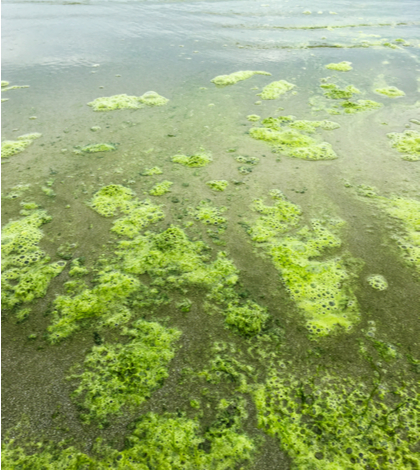Although a danger advisory was put in place July 20 at San Bernardino County’s Silverwood Lake due to the presence of toxic blue-green algae, the Department of Water Resources (DWR) issued a notice to avoid physical contact with the lake’s water on Friday. Testing done this week has resulted in lab results showing an increase in toxin levels.
According to the California Office of Environmental Health Hazard Assessment, “…microcystis is a family of blue green algae that proliferate in slow moving, nutrient rich waters. Unlike most other algae, however, microcystis produce a family of toxins, known as microcystins, which can cause serious illness in people and mortality in livestock and pets.”
Advisories are based on the potential health risks from algae. Exposure to toxic blue-green algae, also known as cyanobacteria, can cause eye irritation, allergic skin rash, mouth ulcers, vomiting, diarrhea, and cold- and flu-like symptoms. Pets can be especially susceptible because they tend to drink while in the water and lick their fur afterwards which can lead to severe illness and death.
Algae bloom conditions can change rapidly, and wind and waves may move or concentrate the bloom into different regions of the reservoir. The algal bloom can accumulate into mats, and scum, form foam at the surface and along the shoreline, and range in color from blue, green, white, or brown.
Boating is currently allowed at Silverwood Lake, but swimming and other water-contact recreation and sporting activities are not considered safe under the danger advisory due to potential adverse health effects. People should also avoid eating fish from the lake until DWR negates the danger warning status.
California’s guidelines on cyanobacteria and harmful algal blooms recommend the following precautions be taken in waters impacted by blue-green algae:
- Avoid wading, swimming, or jet or water skiing in water containing algae blooms, scum, or mats.
- Take care that pets and livestock do not drink the water, swim through algal blooms, scum, or mats, or lick their fur after going in the water. Rinse pets in clean water to remove algae from fur.
- Do not drink, cook, or wash dishes with untreated surface water from these areas under any circumstances. Common water purification techniques such as camping filters, tablets, and boiling do not remove toxins.
- No fish should be consumed under a danger advisory.
- Do not eat mussels or other bivalves collected from these areas. Limit or avoid eating fish. If fish are consumed, remove the guts and liver and rinse filets in clean drinking water.
If you or anyone who has recently been in waters with blue-green algae become ill it is important to get medical treatment immediately. This pertains to both humans and pets and livestock. Be sure to alert medical professionals to the possible contact with blue-green algae. Also, make sure to contact the local county public health department so they can pursue the situation as per their guidelines.
For more information on toxic blue-green algae, go to:
- California Department of Public Health (https://www.cdph.ca.gov/Programs/CCDPHP/DEODC/EHIB/EAS/Pages/HABs.aspx)
- State Water Resources Control Board (https://mywaterquality.ca.gov/habs/what/index.html)
- CA Office of Environmental Health Hazard Assessment (https://oehha.ca.gov/ecotoxicology/general-info/information-microcystins)
- US Environmental Protection Agency: CyanoHAB website (https://www.epa.gov/cyanohabs)
- Centers for Disease Control and Prevention (https://www.cdc.gov/habs/)
 California Water News Daily Your Source For Water News in California
California Water News Daily Your Source For Water News in California


